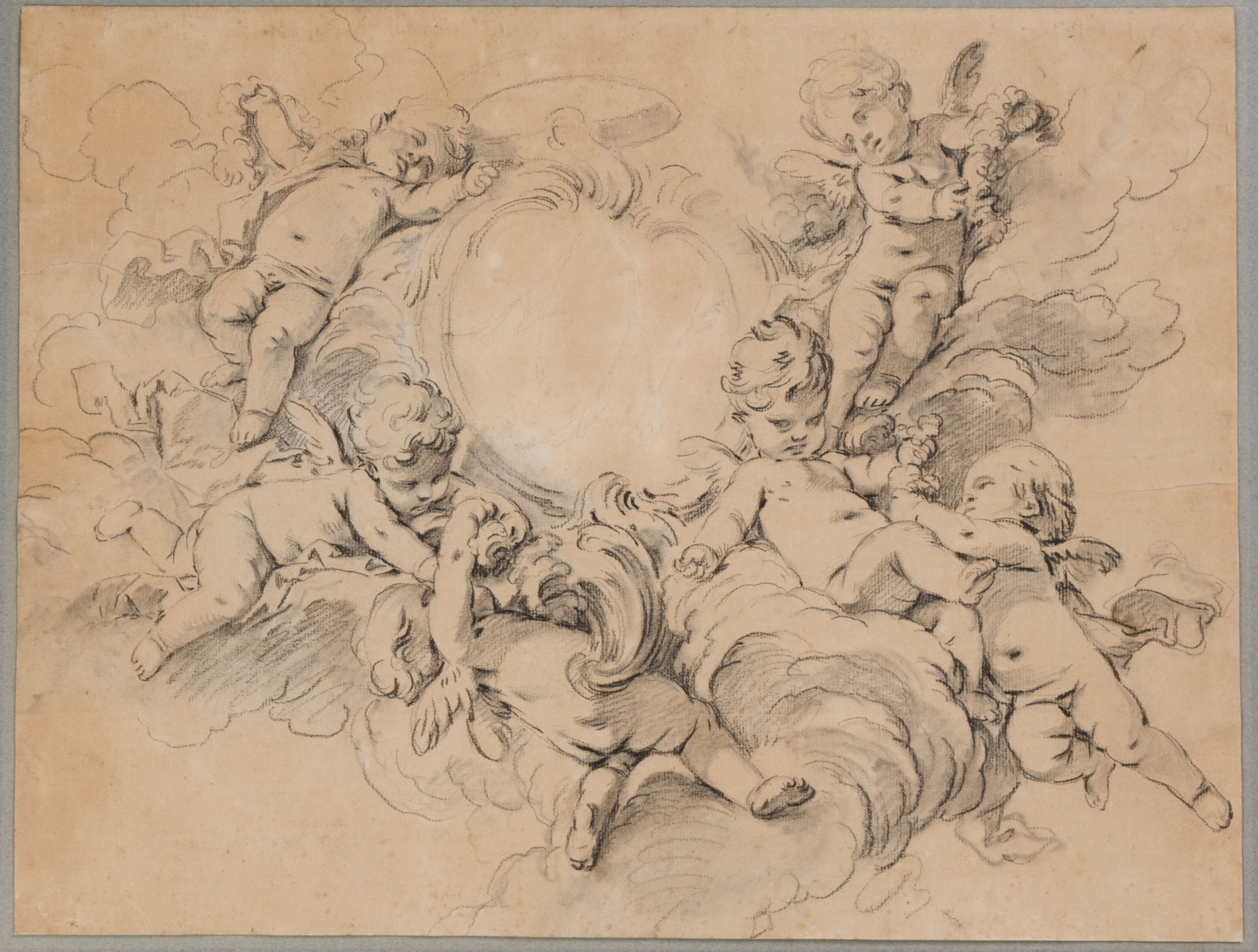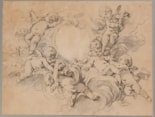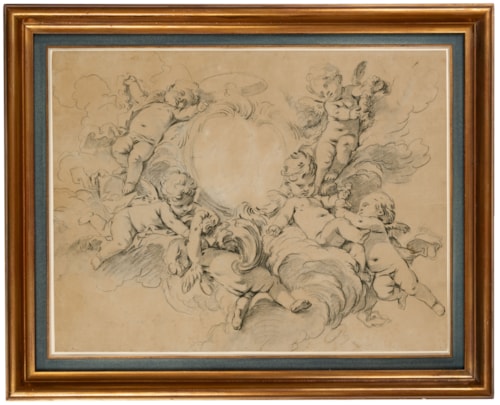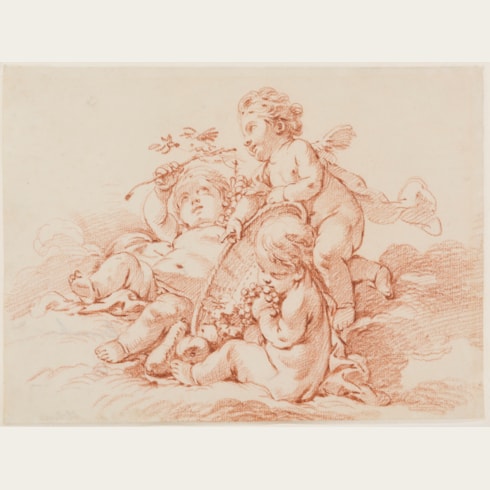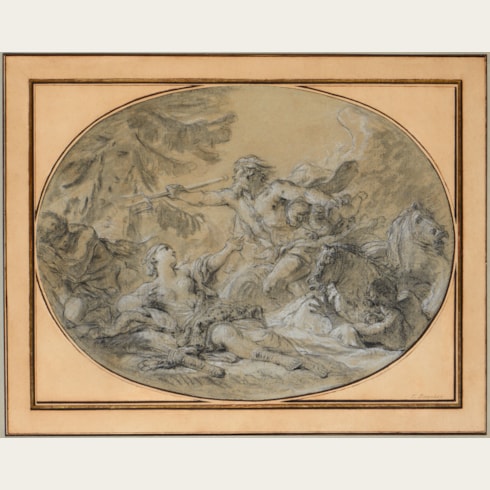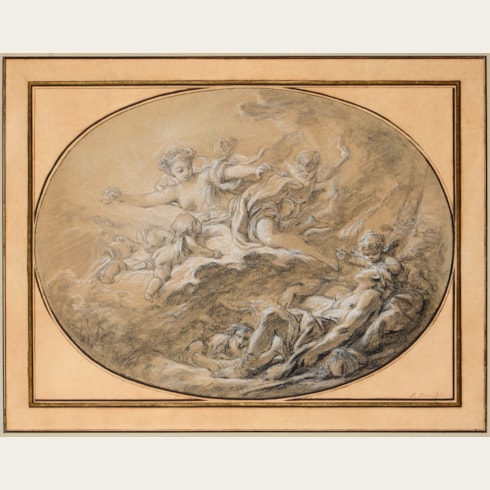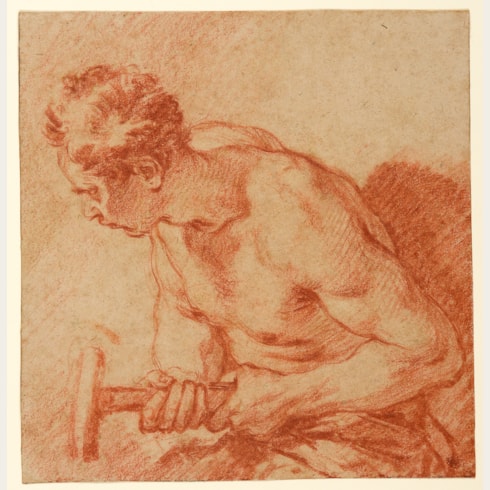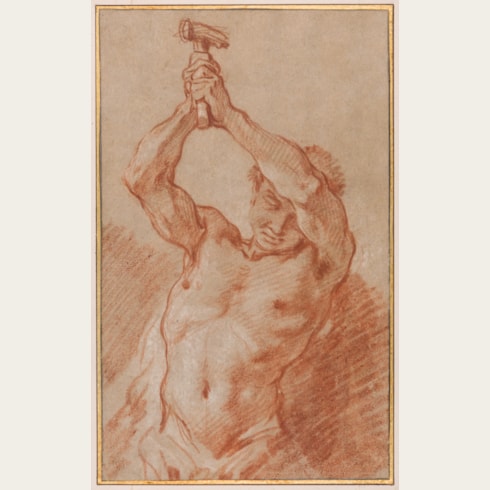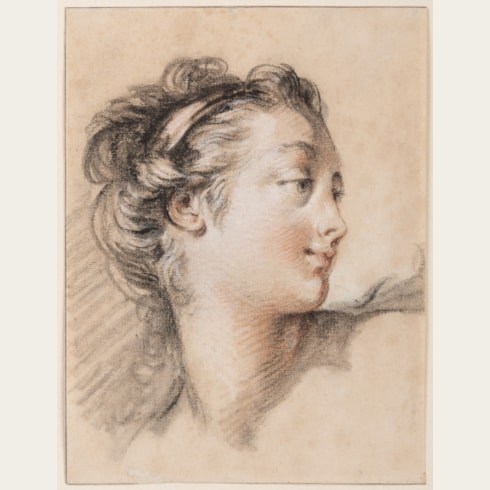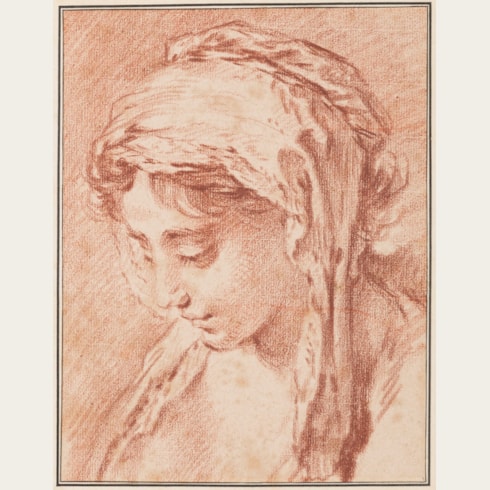François BOUCHER
(Paris 1703 - Paris 1770)
Six Putti in Clouds Supporting a Cartouche with the Letters AN and Surmounted by a Ducal Crown
426 x 558 mm. (16 3/4 x 22 in.)
Relatively few drawings by Boucher related to his ornamental designs have survived. As Françoise Joulie points out, ‘Boucher’s contributions to the decorative arts are well known, but drawings related to his work in this genre are rare. Those few extant drawings reveal his designs for andirons, chandeliers, clocks, musical instruments, screens and silverware, as well as schemes for porcelain for the manufactories of Sèvres and Vincennes. The earlier drawings are strongly marked by the Rococo mode – a style he helped to create – and the later works, especially those after 1760, are imbued with an elegant, discreet Neoclassicism.’
This sizeable sheet aptly highlights Boucher’s abilities as a designer of cartouches and frames, and can be closely related to two equally large and stylistically comparable drawings of putti surrounding an ornamental shield surmounted by a ducal crown. Of a similar technique and scale to the present sheet but oval in format is a drawing formerly in the Houthakker collection and today in the Horvitz collection in Boston, while another related drawing of a cartouche with a coat of arms supported by putti is in the Fitzwilliam Museum in Cambridge.
The late Alastair Laing was the first to suggest that the initials AN visible on the shield in the present sheet indicate that it may have been intended for a commission from Adrien Maurice de Noailles, 3rd Duc de Noailles and Maréchal de France (1678-1766). He also noted that the shield in the Horvitz drawing incorporates the order of the Golden Fleece, and that the Duc de Noailles was one of the very few nobles in France who had earned that particular decoration, which he was awarded in 1702. The scale of the present sheet, and of the two related drawings in the Horvitz and Fitzwilliam Musuem collections, would suggest that all three may have been studies for the decoration of the door panel of the duke’s coach. (Indeed, the fact that Fitzwilliam drawing is pricked for transfer would also support such a connection.) As Laing further points out, ‘It is hardly likely that Boucher would have undertaken the actual task of painting coach panels himself, or even that his studio would have done so…They will instead have been executed by one of the specialist carriage-painters, capable of providing the brilliantly varnished finish that such works required...Thanks to these three drawings, we can see that Boucher was indeed capable of effortlessly turning to making designs for such bagatelles when occasion arose.’
The present drawing once belonged to the art historian Michael Jaffé (1923-1997), who served as director of the Fitzwilliam Museum in Cambridge between 1973 and 1990.
Appointed a professor at the Académie Royale in 1735, Boucher painted numerous easel pictures – pastoral landscapes, religious and mythological subjects, genre scenes, chinoiseries and portraits – for private clients in France, Sweden, Denmark, Germany and Poland, while also producing several tapestry cartoons for the Beauvais and Gobelins manufactories, where he succeeded Jean-Baptiste Oudry as inspecteur des ouvrages in 1755. He designed stage sets and costumes for the Opéra and the Opéra-Comique in the 1740s and created designs for Vincennes and later Sèvres porcelain throughout the 1750s and early 1760s. In 1765 Boucher was named premier peintre du roi, or First Painter to the King, and also appointed director of the Académie Royale. In 1770 he died at his lodgings in the Louvre and was buried in the church of Saint-Germain l’Auxerrois. Among his pupils were Jean-Baptiste Deshays and Pierre-Antoine Baudouin, both of whom became his sons-in-law and predeceased him, as well as Jean-Honoré Fragonard, Jean-Baptiste Le Prince and Gabriel-Jacques de Saint-Aubin.
A gifted draughtsman, François Boucher was as prolific as he was talented, and claimed to have produced ten thousand drawings over a career that lasted some fifty years. He was, in fact, perhaps the most prolific French draughtsman of the eighteenth century, and his drawn oeuvre includes pastoral scenes, nudes, religious, historical and mythological subjects, book illustrations, chinoiseries, landscapes, genre scenes, studies of children and heads, as well as designs for tapestries, porcelain and fountains. Although most of his drawings were preparatory studies for his paintings, Boucher also produced finished drawings as independent works, often adapting and elaborating a head or figure from one of his paintings. While his preference was for black, red, and (particularly in his later years) a dark brown chalk, he also made highly finished drawings in pastel and, at times, drew on coloured paper. As Pierre Rosenberg has succinctly noted, ‘Boucher’s love of drawing never waned with time and success. Admittedly, drawing was kept in its proper place, as a vital link between the conception or the idea of a work or composition, and its realization, its metamorphosis into a painting…To quote Mariette, Boucher “was a born painter”, but he placed great emphasis on drawing throughout his entire career.’ Boucher’s drawings were avidly collected in his lifetime by such connoisseurs as Barthelémy-Augustin Blondel d’Azaincourt, Paul Randon de Boisset, Pierre-Jacques-Onésyme Bergeret de Grancourt, Gilbert Paignon-Dijonval, Jean-Claude Gaspard de Sireuil, Count Carl Gustaf Tessin, and many others.
Boucher's drawn oeuvre includes all manner of subjects, including pastoral scenes, nudes, religious, historical and mythological subjects, book illustrations, chinoiseries, landscapes, nudes, genre scenes, studies of children and heads, as well as designs for tapestries, porcelain and fountains. He produced many finished drawings as independent works, often adapting and elaborating a head or figure from one of his paintings. While his preference was for black, red, and (particularly in his later years) brown chalk, Boucher also made highly finished drawings in pastel and, at times, drew on coloured paper. A large number of his drawings were finished works for collectors and the art market, and many were engraved and reproduced in considerable numbers – often making use of new printmaking techniques that allowed chalk drawings to be reproduced with a high degree of verisimilitude - by such printmakers as Louis-Marin Bonnet, Gilles Demarteau or Gabriel Huquier. His drawings were greatly admired, and while many were preparatory studies for his paintings, others were produced as finished works of art, to be sold to collectors or reproduced by engravers. Indeed, Boucher’s popularity as a draughtsman owes much to the fact that many of his drawings were reproduced and widely distributed as engravings.
Provenance
His sale, London, Christie’s, 29 June 1971, lot 58 (unsold)
Thence by descent.
Literature

